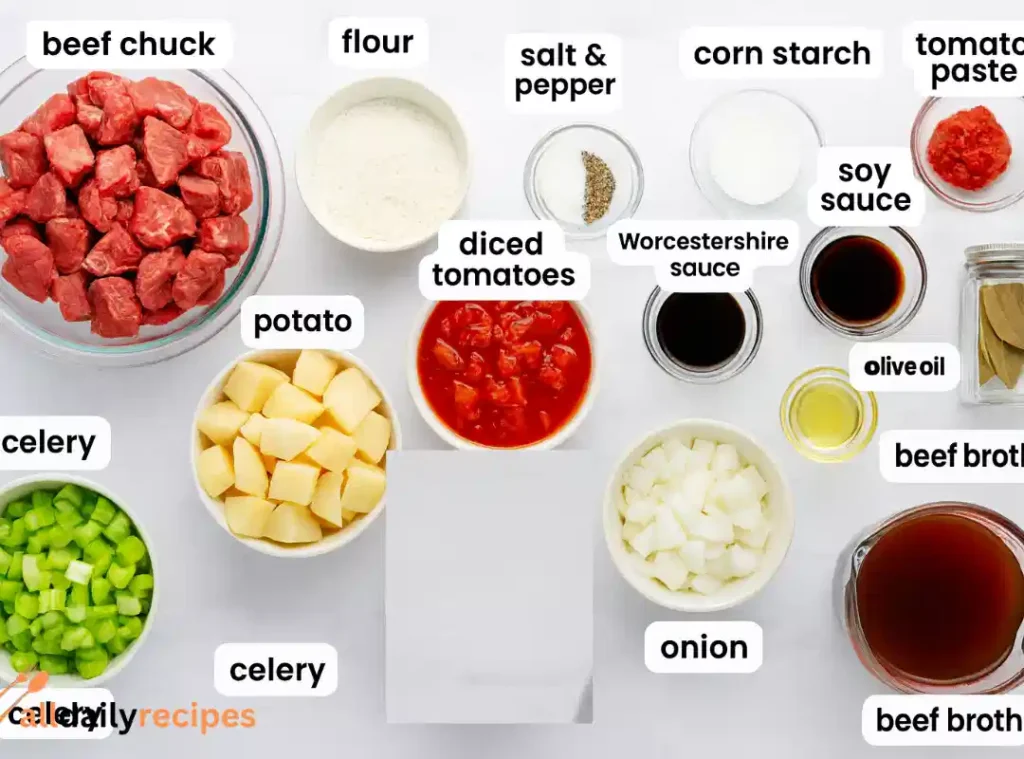Hawaiian beef stew, often called “local-style stew” in the islands, brings a unique twist to classic comfort food. It’s hearty and homey, but what sets it apart is its slightly sweet tomato base and the way it’s traditionally served over rice. Unlike many Western beef stews that use wine or heavy thickeners, this version is bright, flavorful, and made with everyday pantry ingredients.
This stew reflects Hawaii’s multicultural food traditions. You’ll find touches of Japanese, Filipino, Portuguese, and American influences all simmered together in one pot. Locals grow up with this dish, served at family parties, school lunches, or just as a warming meal on rainy days.
One thing that stands out is how simple it is. There’s no long list of spices or unusual techniques. It relies on a tomato-rich broth, tender chunks of beef, and soft vegetables to carry the flavor. And because the flavors develop over time, it gets even better as leftovers.
When served over white rice, the stew becomes more than just a soup—it’s a complete, satisfying meal that fills you up without feeling too heavy. It’s also incredibly flexible. You can add vegetables, adjust seasoning, or make a big batch to freeze for later.
Table of Contents
Ingredients & Smart Substitutes
This version of local-style stew sticks to basic, clean ingredients that come together in one comforting dish.
- 2 pounds beef chuck or stew meat, cut into large cubes – Well-marbled for tenderness
- 1 large onion, diced Adds sweetness and depth
- 3 cloves garlic, minced Brings warmth and aroma
- 3 medium carrots, peeled and cut into thick rounds – Adds color and natural sweetness
- 2 large potatoes, peeled and chopped Soaks up flavor and thickens the stew naturally
- 2 celery stalks, chopped For a bit of light crunch and flavor
- 1 (15 oz) can of tomato sauce Forms the base of the broth
- 1 (15 oz) can of whole or diced tomatoes Adds texture and acidity
- 2 tablespoons tomato paste Adds richness
- 3 cups beef broth or stock (low sodium) Builds the liquid base
- 1 tablespoon sugar Enhances the tomato flavor and adds a subtle sweetness
- 1 teaspoon salt (or to taste)
- ½ teaspoon black pepper
- 1 tablespoon cooking oil
- 2 tablespoons cornstarch + 2 tablespoons water (optional) – To thicken, if desired

Smart Substitutes:
- Swap tomato sauce for crushed tomatoes for a chunkier version
- Add green beans or peas in the last 30 minutes of cooking
- Use sweet potatoes instead of regular potatoes for a different flavor
- For a thicker broth without cornstarch, mash a few potato chunks at the end
This base is flexible and leaves plenty of room to personalize the dish without losing its core flavor.
Equipment & Prep Tips
You don’t need fancy tools to make Hawaiian beef stew, but a few kitchen basics and some prep work go a long way.
Essential Equipment:
- Large pot or Dutch oven (5 to 6 quarts is ideal)
- Sharp knife and sturdy cutting board
- Wooden spoon or spatula
- Small bowl (for thickening slurry, optional)
Prep Tips:
- Use well-marbled beef. It gets more tender during long simmering.
- Cut vegetables into large chunks so they hold their shape while cooking.
- Brown the beef first. Searing it adds a deep, savory flavor to the stew base.
- Layer flavors. Sauté the onion, garlic, and tomato paste before adding liquids to deepen the overall taste.
- Simmer slowly. Keep the pot covered, but not sealed tightly. Leave a small gap to let excess moisture escape.
Good prep helps the stew develop flavor while keeping textures balanced and the meat tender.
Step-by-Step Cooking Instructions
This stew builds flavor in simple stages. Here’s how to do it right:
1. Brown the Beef
Heat oil in a large pot over medium-high heat. Add beef in batches and sear on all sides until browned. Don’t overcrowd the pan. Once browned, transfer beef to a plate.
2. Sauté the Aromatics
In the same pot, reduce heat to medium. Add onion and cook until soft, about 4 to 5 minutes. Stir in garlic and tomato paste, cook for 1 minute until fragrant.
3. Build the Broth
Return beef to the pot. Add tomato sauce, canned tomatoes (with juice), broth, sugar, salt, and pepper. Stir well to combine.
4. Simmer
Bring the mixture to a gentle boil. Lower heat to a simmer, cover loosely, and cook for 45 minutes.
5. Add Vegetables
Add carrots, potatoes, and celery. Simmer for another 45 minutes to 1 hour, until meat is tender and vegetables are cooked.
6. Thicken (Optional)
Mix cornstarch with water in a small bowl. Stir into the stew and simmer uncovered for 5 to 10 minutes until thickened.
7. Serve
Taste and adjust seasoning. Ladle stew over hot white rice and garnish with chopped parsley if desired.
This method gives you a rich, comforting stew with a silky tomato broth and melt-in-your-mouth beef.
Troubleshooting & Common Mistakes
Beef is tough?
It likely needs more time. Keep simmering gently until it softens.
Vegetables are mushy?
Next time, add them later or cut into larger chunks.
Broth too watery?
Thicken with a cornstarch slurry or mash some potatoes directly into the stew.
Too thick?
Add a splash of broth or water to loosen it up.
Lacking flavor?
Add a bit more salt or a spoon of tomato paste. You can also stir in some soy-free seasoning or fresh herbs at the end.
Stews are forgiving just taste as you go and make small adjustments.
Variations & Dietary Tweaks
Add more vegetables: Throw in mushrooms, bell peppers, or green beans.
Make it gluten-free: Stick to cornstarch or mashed potato as your thickener.
For a lighter version: Use leaner cuts of beef and reduce oil. Skip thickening and enjoy a thinner broth.
For added heat:
Add a pinch of crushed red pepper or a small chopped chili.
Extra herbs: A bay leaf or thyme sprig adds more depth if desired.
You can make this stew as rich or light as you like. It’s easy to adjust based on what’s in your kitchen.
Storage, Freezing & Reheating Tips
Storage: Let stew cool completely. Store in airtight containers for up to 4 days in the fridge.
Freezing: Freeze portions in sealed containers for up to 2 months. Leave space at the top for expansion.
Reheating: Thaw overnight in the fridge. Reheat on the stovetop over low heat, adding a splash of broth or water if needed. Microwaving works too—just stir halfway through heating. Stew often tastes better the next day as flavors continue to develop.
Serving Suggestions & Pairings
Rice is key: This stew is traditionally served over white rice. It soaks up the broth and balances the rich flavor.
Other sides: Try a fresh green salad, steamed cabbage, or pickled veggies.
Bread options: A soft dinner roll or Hawaiian sweet bread works great for dipping.
Drinks: Serve with lemon iced tea, ginger tea, or fruit-infused water. Simple pairings let the stew shine while rounding out the meal.
Frequently Asked Questions (FAQ)
Can I make it in a slow cooker?
Can I use tomato juice instead of sauce?
How do I make it less sweet?
Can I double the recipe?
What if I don’t have tomato paste?
Conclusion
Local-style beef stew is more than a recipe it’s a feeling. It’s about making something warm, familiar, and deeply satisfying from simple ingredients.
Let it simmer slowly, taste as you go, and make it your own. Whether you’re cooking for one or a big family, this stew delivers every time.
Once you try it, you might just find yourself making a big pot every weekend and you won’t need a special occasion to do it.

Hawaiian Beef Stew
Ingredients
Method
- Heat oil in a large pot over medium-high heat. Add beef in batches and sear on all sides until browned. Don’t overcrowd the pan. Once browned, transfer beef to a plate.
- In the same pot, reduce heat to medium. Add onion and cook until soft, about 4 to 5 minutes. Stir in garlic and tomato paste, cook for 1 minute until fragrant.
- Return beef to the pot. Add tomato sauce, canned tomatoes (with juice), broth, sugar, salt, and pepper. Stir well to combine.
- Bring the mixture to a gentle boil. Lower heat to a simmer, cover loosely, and cook for 45 minutes.
- Add carrots, potatoes, and celery. Simmer for another 45 minutes to 1 hour, until meat is tender and vegetables are cooked.
- Mix cornstarch with water in a small bowl. Stir into the stew and simmer uncovered for 5 to 10 minutes until thickened.
- Taste and adjust seasoning. Ladle stew over hot white rice and garnish with chopped parsley if desired.


Lovely just what I was looking for.
My husband and i ended up being so happy when Louis managed to finish off his investigations while using the precious recommendations he discovered through your web site. It’s not at all simplistic to simply be making a gift of guidelines which people may have been selling. And now we figure out we need the website owner to appreciate for that. The illustrations you made, the straightforward website navigation, the relationships you will help instill – it’s many wonderful, and it is aiding our son in addition to the family imagine that that idea is brilliant, which is certainly extraordinarily indispensable. Thank you for the whole lot!